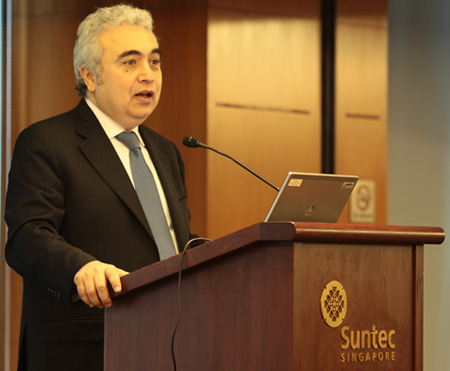
(Picture credit: EMA)
The deal sealed at the recent Durban climate change talks to develop a legally binding climate agreement holds much promise, but more immediate policy action and collaboration is crucial to ensure the sustainable growth of the energy sector. This was one of the key messages from Dr Fatih Birol, Chief Economist of the International Energy Agency (IEA), who was in Singapore on 14 December 2011 to present the highlights from the recently launched World Energy Outlook (WEO) 2011.
Dr Birol was not optimistic about the prospects for the energy sector given the economic and geopolitical landscape, especially in the face of alooming threat of a second dip in the global economy. Budget deficits, unemployment and social problems were diverting governments' attention and funding away from energy issues and clean technologies. To make matters worse, the turmoil in Middle East and North Africa (MENA) had raised perceived risks of investment in the region. Should the production levels in MENA not be able to meet rising demand due to delays in capital investment, this could lead to a surge in oil prices and diversion of market share away from the region in the long run.
In the short to medium term, coal would continue to dominate the fuel mix, while natural gas and renewables were likely to be the key drivers of growth. However, more international collaboration and oversight was necessary to ensure sustainable growth of these sectors. Turning to nuclear power post-Fukushima, Dr Birol said that a slowdown could increase the cost of energy imports, reduce diversity of the fuel mix and make it harder and more expensive to mitigate the effects of climate change. The impact would especially be felt on countries that rely heavily on nuclear energy.
Dr Birol stressed that international policy debate must include the new players as the emerging economies were projected to account for more than 50% of increase in global energy demand. According to Dr Birol, "Energy decisions in Beijing, Delhi and Moscow will impact the rest of the world". He recommended reading China's five-year plan for anyone seeking to understand China's energy policies and how they would impact on the global market.
Before concluding his presentation, Dr Birol mentioned that based on IEA's projections, the window for action towards meeting the 2 degrees Celsius climate change goal is fast closing. Without further action,by 2017 all CO2emissions permitted in the 450 Scenario will be "locked-in" by existing power plants, factories, buildings, etc. He called on governments to take affirmative action quickly as it would only be more challenging and expensive by the year.
The World Energy Outlook is the IEA's flagship publication and is widely recognised as the most authoritative source for global energy projections and analysis